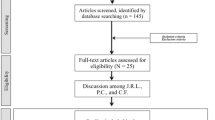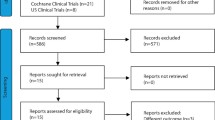Abstract
Purpose
To evaluate the effect of the different surgical techniques used in the treatment of obstructive sleep apnea (OSA) on the postoperative voice and nasalance, and to conduct a meta-analysis through the assessment of postoperative changes.
Methods
Systematic literature review and meta-analysis of published data using the data sources, MEDLINE, Google Scholar, Cochrane, and SAGE. All studies published in English specifying any upper airway surgery for treatment of snoring and/or OSA were included, provided they indicated the pre- and postoperative mean ± standard deviation (SD) values for voice parameters and nasality. The primary outcomes were the changes in preoperative–postoperative mean values of fundamental frequency (mF0), jitter, shimmer, and nasalance scores.
Results
After removal of duplications, 214 studies were potentially relevant, and 25 studies ultimately met the criteria for inclusion in the present review. Of the 25 studies evaluated in this review, 12 studies with 379 patients were available for the meta-analysis calculations. In general, a fixed-effects model was used to analyze the data in the subgroups. The meta-analysis results showed no significant differences in either subgroup analysis between the preoperative and postoperative assessments of mF0, jitter, shimmer, oral nasalance, nasal nasalance, and oronasal nasalance (All had values of p > 0.05).
Conclusion
The results of this meta-analysis indicated no significant effect of surgical treatments for snoring or OSA on glottic functioning and nasalance parameters, regardless of surgery type. Further prospective studies are needed to assess more parameters for detailed acoustic analyses.



Similar content being viewed by others
References
Karakoc O, Akcam MT, Genc H et al (2015) Do pharyngeal surgeries for snoring and obstructive sleep apnea have an impact on nasalance scores? J Craniofac Surg 26(7):2213–2216
Park SK, Lee YS, Kang YA et al (2018) The effects of uvulopalatal flap operation on speech nasalance and the acoustic parameters of the final nasal consonants. Auris Nasus Larynx 45(2):311–319
Soneghet R, Santos RP, Behlau M et al (2002) Nasalance changes after functional endoscopic sinus surgery. J Voice 16(3):392–397
Rihkanen H, Soini I (1992) Changes in voice characteristics after uvulopalatopharyngoplasty. Eur Arch Otorhinolaryngol 249(6):322–324
Han D, Xu W, Hu R et al (2012) Voice function following Han’s uvulopalatopharyngoplasty. J Laryngol Otol 126(1):47–51
Greene JS, Zipfel TE, Harlor M (2004) The effect of uvulopalatopharyngoplasty on the nasality of voice. J Voice 18(3):423–430
Atan D, Ozcan KM, Ozcan M et al (2017) The effect of anterior palatoplasty plus modified expansion sphincter pharyngoplasty on voice performance in obstructive sleep apnea syndrome. J Craniofac Surg 28(5):e464–e467
Van Lierde KM, Van Borsel J, Moerman M et al (2002) Nasalance, nasality, voice, and articulation after uvulopalatopharyngoplasty. Laryngoscope 112(5):873–878
Birkent H, Soken H, Akcam T et al (2008) The effect of radiofrequency volumetric tissue reduction of soft palate on voice. Eur Arch Otorhinolaryngol 265(2):195–198
Abu El-ella MY, Eldin HE, Malki KH et al (2010) Effect of classic uvulopalatopharyngoplasty and laser-assisted uvulopalatopharyngoplasty on voice acoustics and speech nasalance. Ann Saudi Med 30(6):459–463
Li HY, Lee LA, Fang TJ et al (2010) Evaluation of velopharyngeal function after relocation pharyngoplasty for obstructive sleep apnea. Laryngoscope 120(5):1069–1073
Akpinar ME, Kocak I, Gurpinar B et al (2011) Effects of soft palate implants on acoustic characteristics of voice and articulation. J Voice 25(3):381–386
Eun YG, Shin SY, Kim SW (2013) Effects of uvulopalatopharyngoplasty with or without radiofrequency tongue base reduction on voice in patients with obstructive sleep apnea. Laryngoscope 123(7):1806–1810
Askar SM, Quriba AS, Hassan EM et al (2017) Voice and swallowing outcomes after hyoid suspension surgery in patients with obstructive sleep apnea. Folia Phoniatr Logop 69(5–6):271–277
Haraldsson PO, Karling J, Lysdahl M et al (2002) Voice quality after radiofrequency volumetric tissue reduction of the soft palate in habitual snorers. Laryngoscope 112(7 Pt 1):1260–1263
Coleman RF, Sly DE (1991) Preoperative and postoperative voice analysis of uvulopalatopharyngoplasty patients. Arch Otolaryngol Head Neck Surg 117(12):1345–1349
Behrman A, Shikowitz MJ, Dailey S (2002) The effect of upper airway surgery on voice. Otolaryngol Head Neck Surg 127(1):36–42
Murry T, Bone RC (1989) Acoustic characteristics of speech following uvulopalatopharyngoplasty. Laryngoscope 99(12):1217–1219
Sundberg J (1977) The acoustics of the singing voice. Sci Am 236(3):82–4, 6, 8–91
Brosch S, Matthes C, Pirsig W et al (2000) Uvulopalatopharyngoplasty changes fundamental frequency of the voice–a prospective study. J Laryngol Otol 114(2):113–118
Bertino G, Matti E, Migliazzi S et al (2006) Acoustic changes in voice after surgery for snoring: preliminary results. Acta Otorhinolaryngol Ital 26(2):110–114
Bowen AJ, Nowacki AS, Kominsky AH et al (2018) Voice and swallowing outcomes following hypoglossal nerve stimulation for obstructive sleep apnea. Am J Otolaryngol 39(2):122–126
Vahatalo K, Laaksonen JP, Tamminen H et al (2005) Effects of genioglossal muscle advancement on speech: an acoustic study of vowel sounds. Otolaryngol Head Neck Surg 132(4):636–640
Nakai K, Sakakura A, Takahashi H et al (1996) Articulation after uvulopalatopharyngoplasty. Eur Arch Otorhinolaryngol 253(7):417–420
Hoolsema EM (1999) Cautery-assisted palatal stiffening operation and nasalance of speech. Ann Otol Rhinol Laryngol 108(7 Pt 1):705–707
Mora R, Jankowska B, Crippa B et al (2009) Effects of uvulopalatopharyngoplasty with harmonic scalpel on speech and voice. Eur Arch Otorhinolaryngol 266(12):1989–1994
Yang CC, Wang YP, Chang CW (2016) Changes in the nasalance of vowels within the first week following uvulopalatopharyngoplasty. Ear Nose Throat J 95(2):E43–E46
Arora A, Chaidas K, Garas G et al (2016) Outcome of TORS to tongue base and epiglottis in patients with OSA intolerant of conventional treatment. Sleep Breath 20(2):739–747
Funding
This research did not receive any specific Grant from funding agencies in the public, commercial, or not-for-profit sectors.
Author information
Authors and Affiliations
Contributions
All persons designated as the authors have participated sufficiently in the work to take public responsibility for the content of the manuscript. All the authors ensure that they all gave substantial contributions: (1) to conception and design or analysis and interpretation of data (2) drafting of the manuscript or revising it for important intellectual content and (3) for final approval of the version to be published, and (4) agreement to be accountable for all aspects of the work in ensuring that questions related to the accuracy or integrity of any part of the work are appropriately investigated and resolved.
Corresponding author
Ethics declarations
Conflict of interest
The authors declare that they have no conflicts of interest. This work is a meta-analysis review and no new original data have been analyzed.
Additional information
Publisher's Note
Springer Nature remains neutral with regard to jurisdictional claims in published maps and institutional affiliations.
Rights and permissions
About this article
Cite this article
Binar, M., Akcam, T., Vardareli, O.S. et al. Voice outcomes for patients undergoing surgery for obstructive sleep apnea: a systematic review and meta-analysis. Eur Arch Otorhinolaryngol 277, 3261–3281 (2020). https://doi.org/10.1007/s00405-020-06101-9
Received:
Accepted:
Published:
Issue Date:
DOI: https://doi.org/10.1007/s00405-020-06101-9




